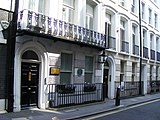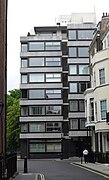St James's Place
Street in the City of Westminster, London, England From Wikipedia, the free encyclopedia
St James's Place is a street in the St James's district of London near Green Park.[1] It was first developed around 1694, the historian John Strype describing it in 1720 as a "good Street ... which receiveth a fresh Air out of the Park; the Houses are well-built, and inhabited by Gentry ..."[2][3] Henry Benjamin Wheatley wrote in 1870 that it was "one of the oddest built streets in London."[3]

Spencer House, which was commissioned by the 1st Earl Spencer in 1756, stands at number 27 and is now listed as Grade I.[4][5] A further thirteen properties are Grade II listed; Number 4 is Grade II* listed.[6]
Notable residents

- Joseph Addison (1672–1719), author and politician who founded The Spectator, lived here in 1710.[3]
- Eustace Budgell (1686–1737), English writer and politician.[3]
- Sir Francis Burdett (1770–1844), reforming politician known as "Old Glory", lived at number 25 from 1820 to 1844.[7]
- Sir Francis Chichester (1901–1972), pioneer aviator, sailor and author, lived at number 9 from 1944 to 1972.[8]
- Lord Randolph Henry Spencer-Churchill (1849–1895), British statesman, lived at number 29 from April 1880 to late 1882.[9]
- James Craggs the Younger (1686–1721), English politician.[3]
- Mary Delany (1700–1788), English artist and writer.[3]
- Captain Basil Hall (1788–1844), Scottish traveller and author, lived at number 4.[3]
- Cornelius Hatfield, Jr. (1755–1823), American Revolutionary War Loyalist partisan captain from Elizabeth, New Jersey.[10]
- John Hick (1815–1894), English industrialist, art collector and Conservative Party politician, lived at number 4.[11][12]
- Henry Grattan (1746–1820), Irish politician.[3]
- White Kennett (1660–1728), Bishop of Peterborough.[3]
- John Lubbock (1803–1865), English banker and scientist.[3]
- Stafford Northcote, 1st Earl of Iddesleigh (1818–1887), British statesman, lived at number 30.[citation needed]
- Richard Rigby (1722–1788), English civil servant and politician.[3]
- Samuel Rogers (1763–1855), 19th-century English poet.[13]
- Oscar Wilde (1854–1900), Irish playwright, novelist, essayist, and poet, rented rooms at 10–11 for five months in 1893–1894.[citation needed]
- John Wilkes (1725–1797), English journalist and politician, lived there in 1756.[3]
Gallery
- Blue Plaque at 4 St James's Place
- Francis Chichester Map and Guide publishing house at 9 St James's Place
- 10-11 St James's Place
See also
References
External links
Wikiwand - on
Seamless Wikipedia browsing. On steroids.




